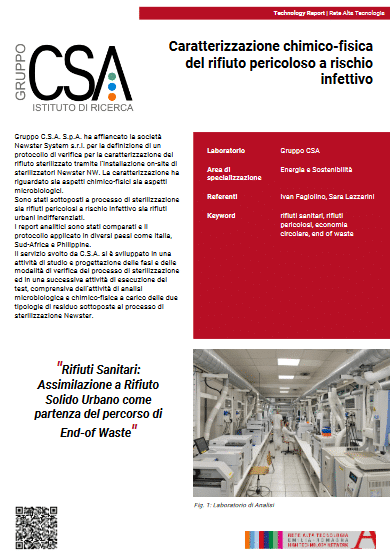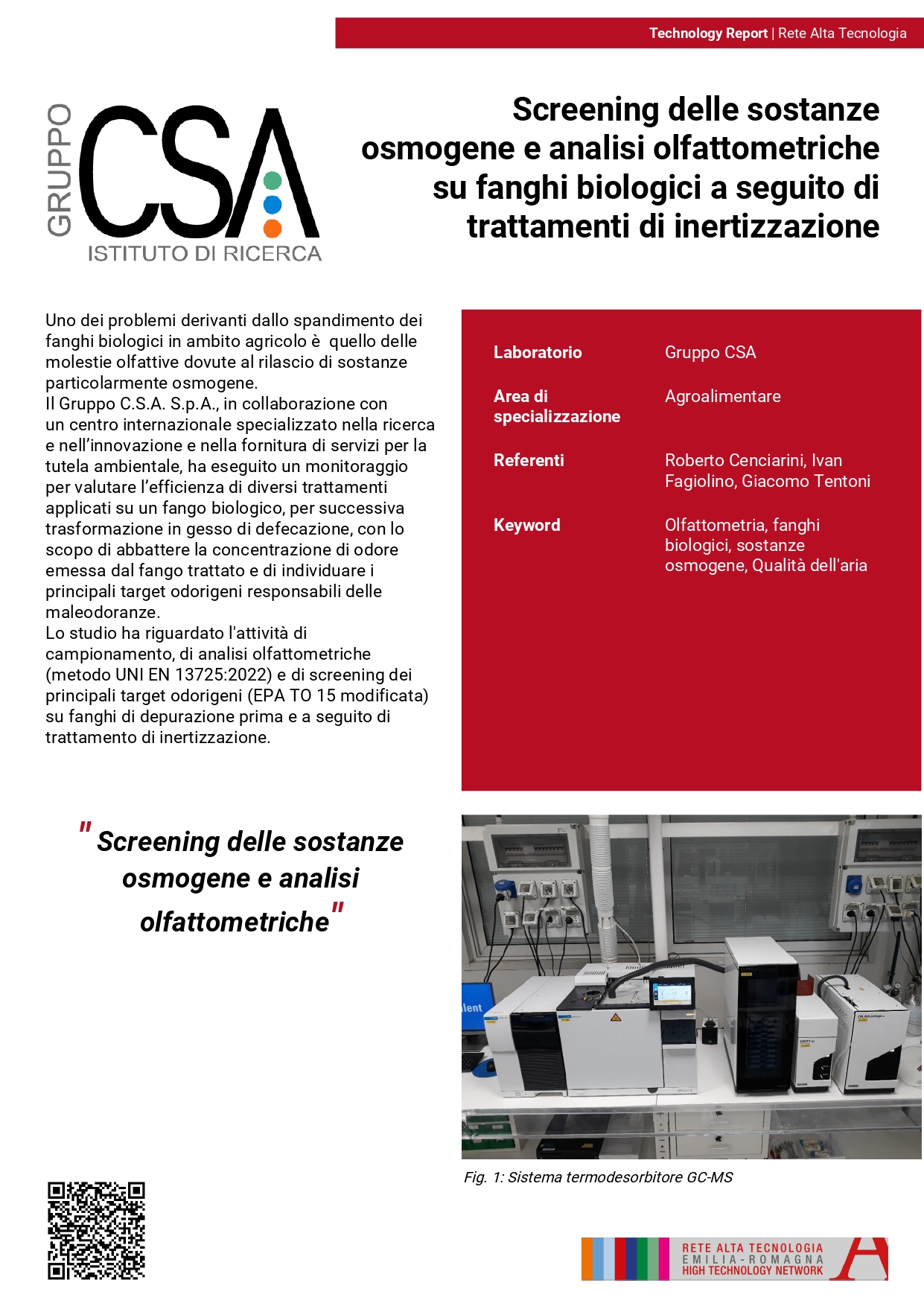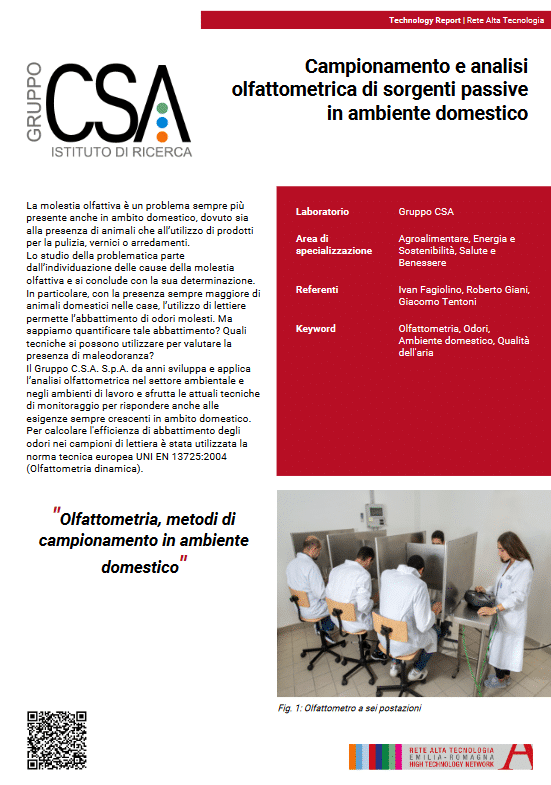Progetti
Le competenze acquisite nel corso di questi anni hanno permesso al Gruppo C.S.A. S.p.A. di sviluppare un know-how di incredibile valore nel campo degli studi ambientali.
C.S.A. S.p.A. segue e coordina progetti complessi ed interdisciplinali che richiedono esperienza e professionalità elevate: questo rende il Gruppo un partner affidabile e sempre all’avanguardia.

Caratterizzazione chimico-fisica del rifiuto pericoloso a rischio infettivo
Il Gruppo C.S.A. S.p.A. ha affiancato la società Newster System s.r.l. per la definizione di un protocollo di verifica per la caratterizzazione del rifiuto sterilizzato tramite l’installazione on-site di sterilizzatori Newster NW.
La caratterizzazione ha riguardato sia aspetti chimico-fisici sia aspetti microbiologici. Sono stati sottoposti a processo di sterilizzazione sia rifiuti pericolosi a rischio infettivo sia rifiuti urbani indifferenziati.
Scarica il documento per conoscere maggiori dettagli! ⇒
Protocollo Implementato
- Analisi settimanale dei quantitativi di rifiuto urbano indifferenziato e di rifiuto pericoloso a rischio infettivo;
- Reporting e analisi comparata dei quantitativi al fine di individuare i rapporti tra le due diverse quantità studiate;
- Campionamento di 7 kg di rifiuto a rischio infettivo suddivisi 1 kg al giorno (Campione A);
- Esecuzione di un ciclo di sterilizzazione giornaliero con rifiuto urbano e campionamento di 1 kg per 7 gg. In totale 7 kg (CAMPIONE B);
- Preparazione di un campione misto tra il rifiuto ospedaliero sterilizzato e il rifiuto urbano indifferenziato anch’esso sterilizzato in rapporto 1:3,5 (CAMPIONE C);
- Esecuzione del medesimo protocollo analitico su tutti e tre i campioni; analisi comparata dei parametri analizzati usando come benchmark i valori del campione di riferimento B.
Aspetti Innovativi e Risultati
Attraverso la ricezione di campioni di rifiuto il monitoraggio è stato eseguito anche presso il Karl Bremer Hospital, Cape Town in South Africa e Rizal Medical Center Barangay Bagong Ilog Pasig City nelle Filippine.
I risultati ottenuti dalle verifiche e dalle analisi di laboratorio condotte hanno permesso di dimostrare che le performance degli sterilizzatori Newster rispettano i requisiti internazionali per la sterilizzazione dei rifiuti sanitari, rappresentato dal IV livello STAATT (6log10).
E’ emerso che le due matrici presentano la medesima caratterizzazione chimico-fisica senza alcuna caratteristica di pericolo a supporto del recente adeguamento normativo.
Screening sostanze osmogene e analisi olfattometriche fanghi biologici
Il Gruppo C.S.A. S.p.A. ha collaborato con un centro internazionale specializzato nella ricerca ed innovazione e nella fornitura di servizi per la tutela ambientale.
E’ stato eseguito un monitoraggio per valutare l’efficienza dei trattamenti eseguiti su fango biologico e sui gessi di defecazione, con lo scopo di abbattere la concentrazione di odore emessa ed individuare i principali target odorigeni responsabili delle maleodoranze.
Scarica il documento per conoscere maggiori dettagli! ⇒
Protocollo Implementato
- Attività di campionamento e analisi sul fango di depurazione: sono stati prelevati campioni di aria emessa dal materiale oggetto di studio per le analisi olfattometriche e per lo screening delle sostanze osmogene.
- Attività di campionamento e analisi sul fango di depurazione trattato: il campione di fango biologico è stato sottoposto a 6 trattamenti differenti per trasformazione in gessi di defecazione. Le aliquote ottenute sono state consegnate presso il Laboratorio del Gruppo C.S.A. S.p.A. per il prelievo dei campioni di aria e l’esecuzione delle analisi olfattometriche e dello screening delle sostanze osmogene.
- Attività di elaborazione di studio comparativo dei risultati: sono stati elaborati i dati analitici ed eseguita l’analisi comparativa tra i campioni di fango di depurazione ed i gessi di defecazione.
Aspetti Innovativi e Risultati
L’analisi olfattometrica, oltre a permettere la valutazione di basse concentrazioni di sostanze odorigene altrimenti non determinabili, rende possibile la determinazione della capacità di abbattimento dell’odore a seguito del trattamento di inertizzazione.
Lo screening delle sostanze osmogene permette la caratterizzazione dei principali target odorigeni, a bassi livelli di soglia olfattiva, e della variazione di concentrazione e di pattern analitico.
L’uso delle due tecniche permette da un lato di avere una percezione effettiva della presenza di odore e dall’altro di poter capire nello specifico quali sono le sostanze responsabili della molestia olfattiva al fine di poterne ottimizzare il trattamento per l’abbattimento dell’odore.
Campionamento e analisi olfattometrica sorgenti passive in ambiente domestico
Il Gruppo C.S.A. S.p.A. applica l’analisi olfattometrica e sfrutta le tecniche di monitoraggio per rispondere alle crescenti esigenze in ambito domestico legate alla presenza di animali e all’uso di prodotti per la pulizia, vernici e arredamenti.
Lo studio si concentra sull’efficacia dell’uso delle lettiere nell’abbattimento degli odori generati.
L’efficienza di abbattimento degli odori nei campioni di lettiera è stata utilizzata la norma tecnica europea UNI EN 13725:2004.
Scarica il documento per conoscere maggiori dettagli! ⇒
Protocollo Implementato
Sulla base della normtiva di riferimento la determinazione oggettiva della concentrazione di odore di un campione aeriforme, prelevato da un’emissione di odori proveniente da fonti puntuali o superficiali, avviene mediante olfattometria dinamica con tecnici come valutatori dell’odore.
L’analisi odorigena sulla lettiera è stata eseguita mediante una Wind Tunnel del tipo Low Speed Wind Tunnel.
I campioni sono stati poi sottoposti a misurazione mediante olfattometro automatico a 6 operatori; per ogni campione sono state eseguite le seguenti misurazioni:
- determinazione del flusso e della concentrazione degli odori nel contenitore vuoto della lettiera contenente una soluzione acquosa salina di ammoniaca;
- determinazione del flusso e della concentrazione degli odori della sola lettiera pulita;
- determinazione del flusso di odore e della concentrazione di odore della lettiera con l’aggiunta di urina sintetica di gatto.
Aspetti Innovativi e Risultati
Rispetto ad altre determinazioni strumentali l’analisi olfattometrica permette di valutare, grazie alla sensibilità della percezione sensoriale, basse concentrazioni di sostanze odorigene altrimenti non determinabili.
Questa tecnica, nel presente caso studio, ha permesso di determinare con una buona accuratezza la capacità di abbattimento dell’odore da parte di materiali adsorbenti (lettiere).
In precedenti studi, la stessa valutazione, eseguita determinando l’emissione di ammoniaca per adsorbimento su fiale di gel di silice e successiva analisi strumentale, non ha dato risultati soddisfacenti.
Contatta il Gruppo C.S.A. S.p.A.
Compila il form con la tua richiesta



